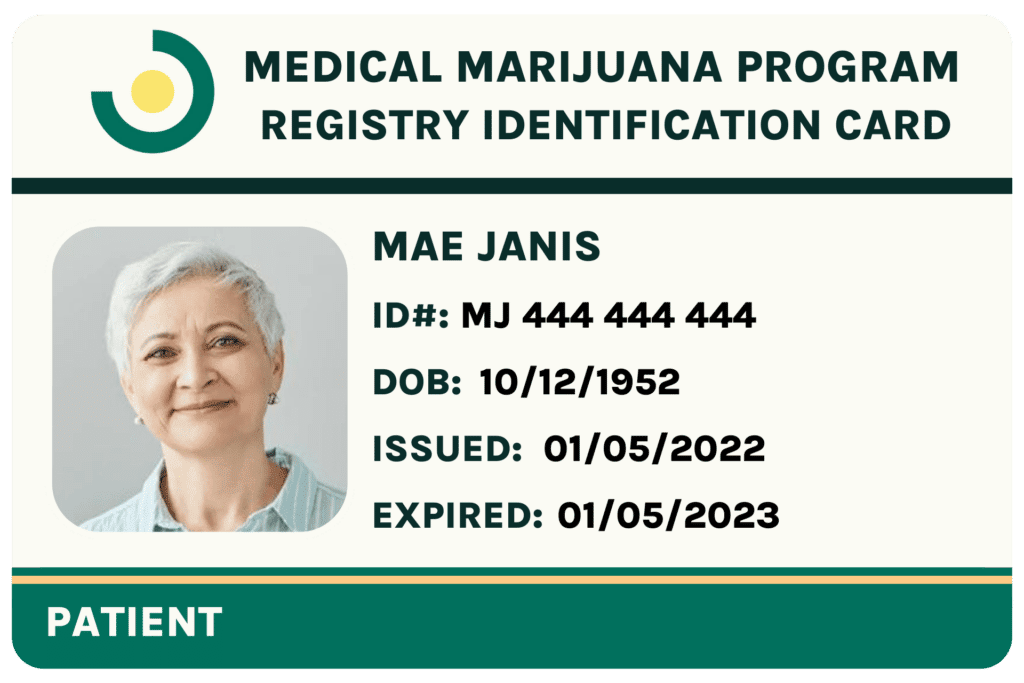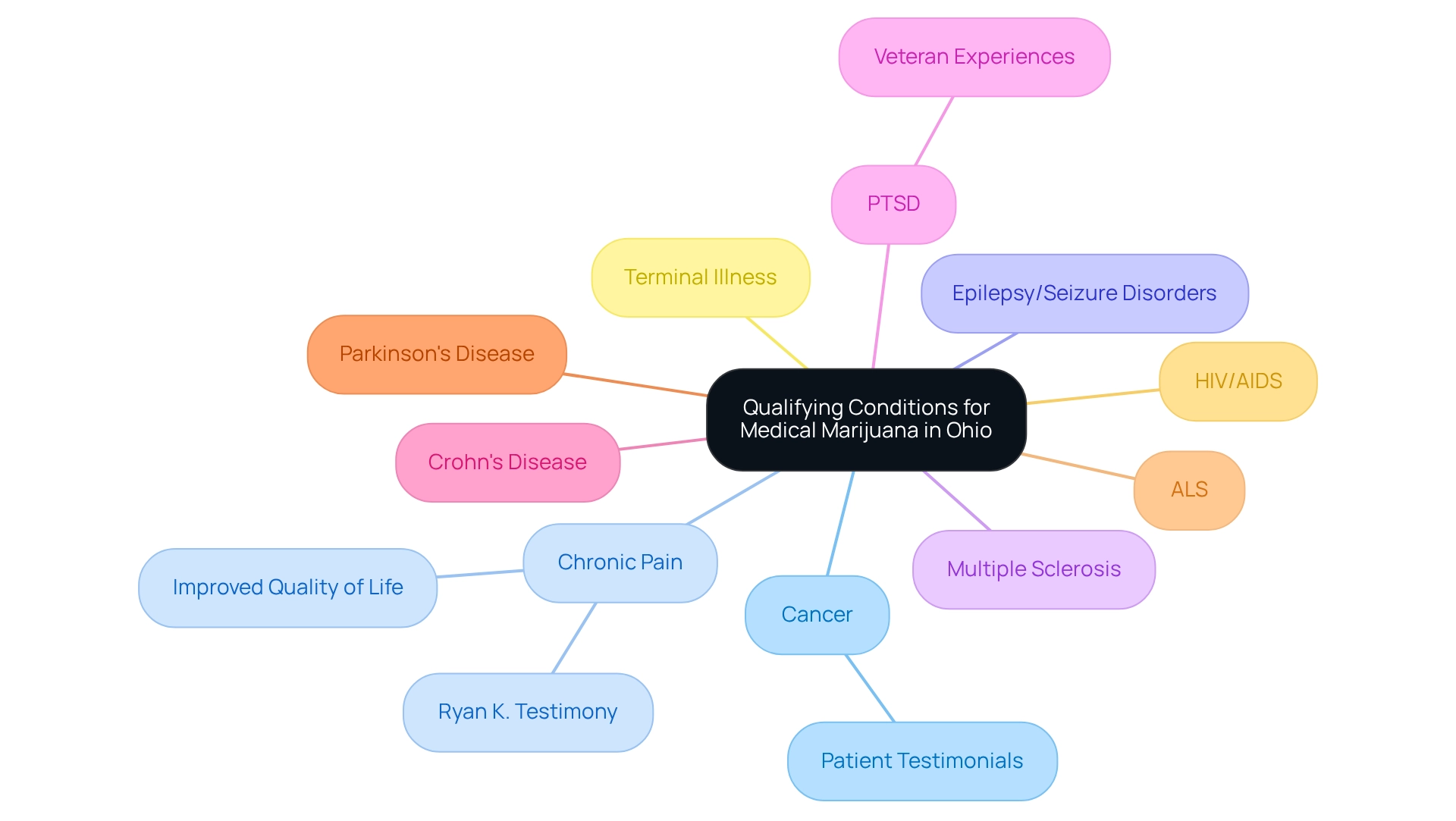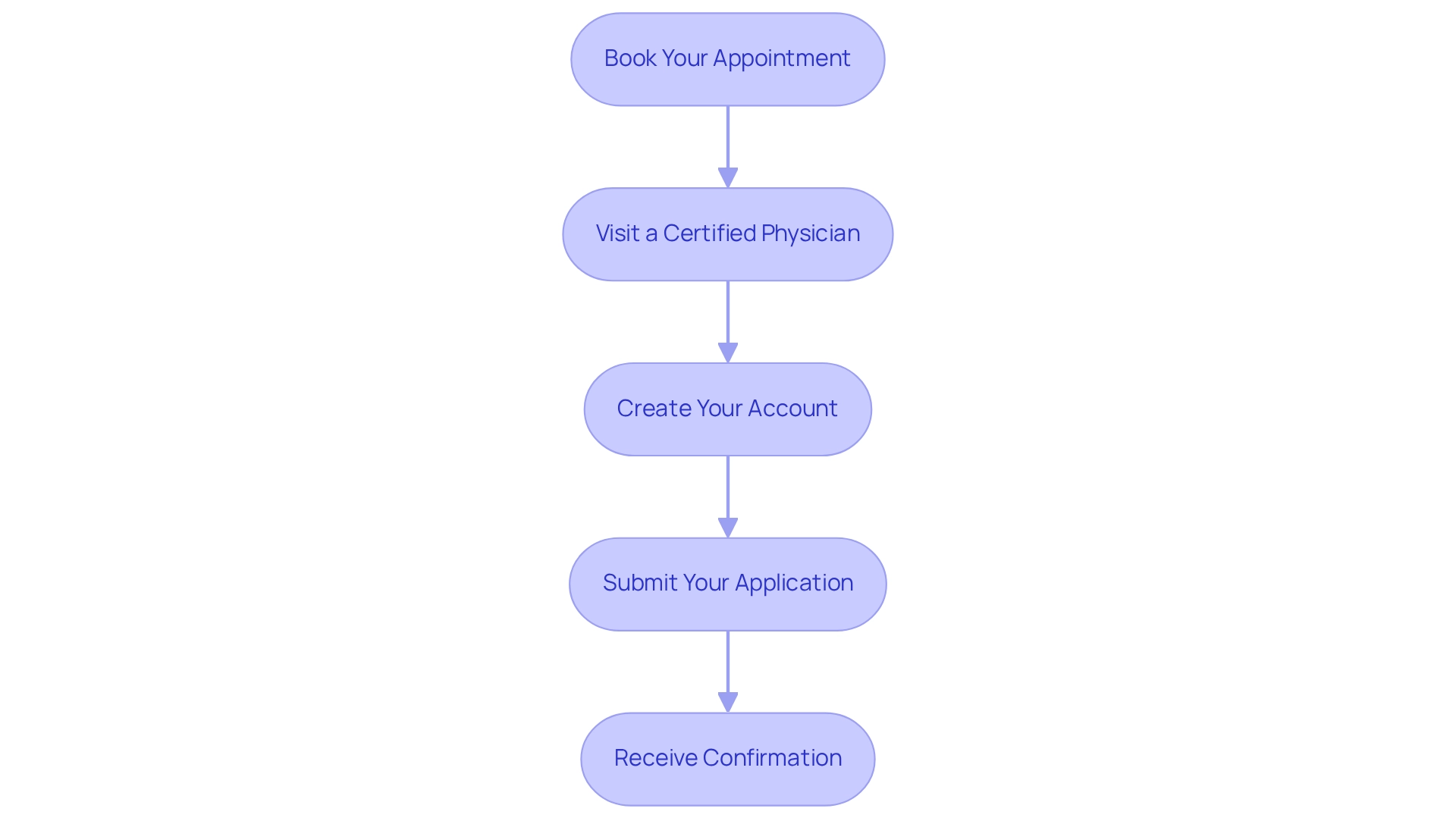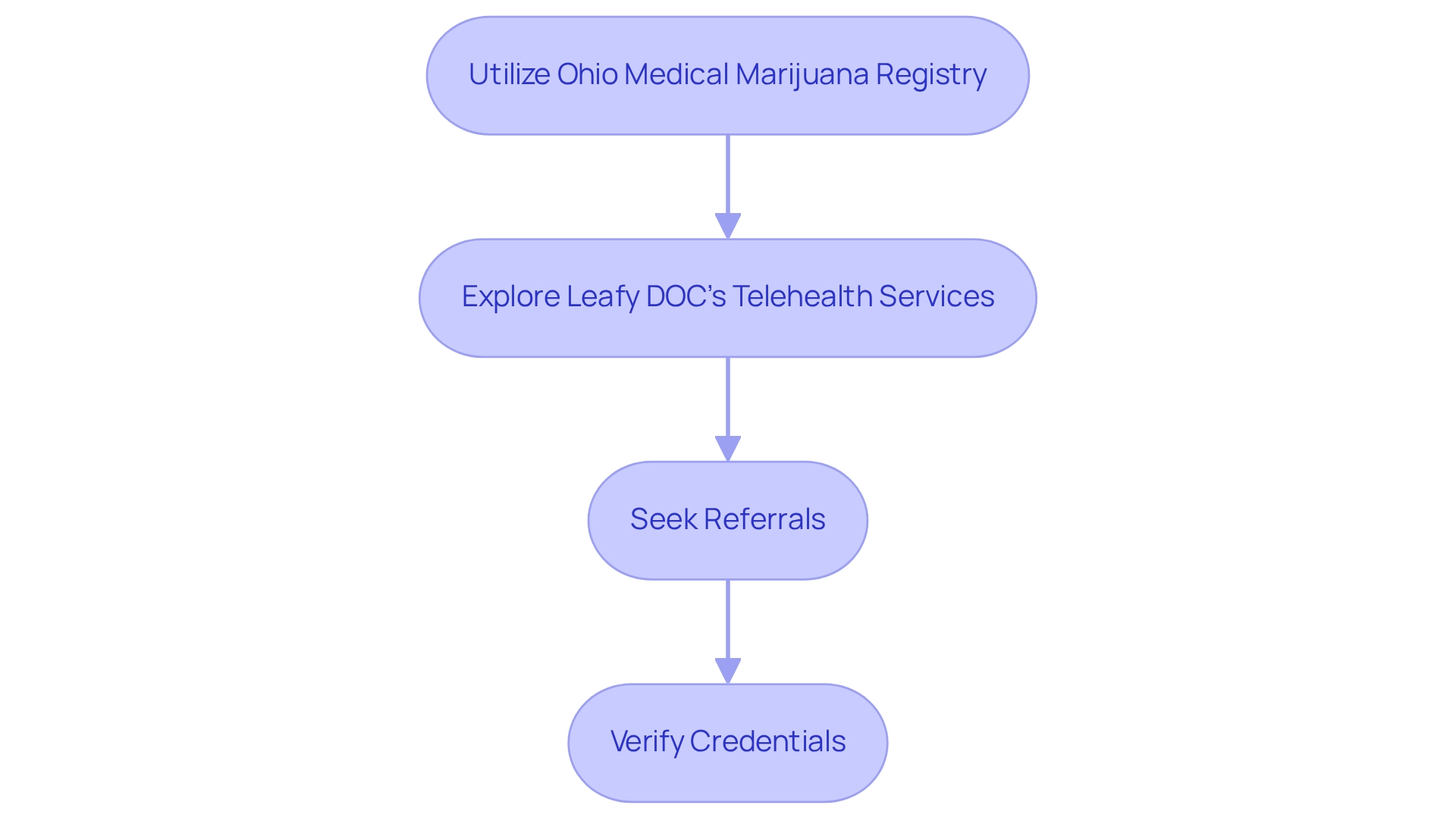Understanding the Ohio Medical Marijuana Registry: A Complete Tutorial for Patients
by Maya Green · April 9, 2025
Explore the Ohio Medical Marijuana Registry’s process for patients to access medical cannabis legally.

Overview
The Ohio Medical Marijuana Registry offers a compassionate pathway for patients facing health challenges to gain legal access to medical cannabis. Through a simple online application and telehealth services, individuals can find relief. As of 2025, the registry has grown to include over 200,000 registered individuals, a testament to its importance in enhancing the quality of life for many.
It’s important to recognize how therapeutic cannabis can make a difference. Patient testimonials and expert insights highlight its effectiveness for various conditions. You may find that this access not only alleviates physical symptoms but also fosters a sense of hope and well-being. By understanding the positive impact of medical cannabis, we can encourage those in need to explore this option and take the necessary steps toward improved health.
Introduction
In Ohio, the landscape of medical marijuana is rapidly evolving, and for many patients, this transformation represents a vital opportunity for relief from various qualifying conditions. The state’s Medical Marijuana Registry, established under Ohio House Bill 523, serves as a crucial lifeline, connecting patients with licensed healthcare providers and simplifying the process of obtaining medical cannabis. As of 2025, over 200,000 patients have registered, highlighting a significant demand for therapeutic options like cannabis to help manage chronic pain, anxiety, and PTSD.
It’s important to remember that navigating this process can feel overwhelming. However, with innovative telehealth services such as those offered by Leafy DOC, patients can now find support in registering and accessing their medication from the comfort of their homes. This article delves into the intricacies of the Ohio Medical Marijuana Registry, exploring everything from the registration process and qualifying conditions to the operational dynamics of dispensaries. Our goal is to ensure that you feel well-informed and empowered on your journey toward improved health and well-being.
Overview of the Ohio Medical Marijuana Registry
The state-managed Marijuana Registry is a vital initiative designed to help individuals with qualifying health issues legally obtain cannabis. Established under House Bill 523 in Ohio, the Ohio medical marijuana registry serves as an essential link between individuals and licensed healthcare professionals who can recommend therapeutic cannabis. To receive a cannabis prescription card, individuals must complete an online registration process, which requires them to provide necessary documentation and a thorough health history.
This card allows them to purchase cannabis products from authorized dispensaries throughout the state.
As of 2025, the Ohio medical marijuana registry has experienced remarkable growth, with over 200,000 individuals registered. This surge indicates a strong demand for cannabis for therapeutic use, highlighting the registry’s crucial role in providing access to essential treatment options for those suffering from chronic pain, anxiety, PTSD, and other qualifying conditions. It’s important to remember that, in contrast, 55.9% of voters in Florida opposed cannabis legalization for adult use, which underscores the ongoing challenges and varying acceptance of cannabis across states, potentially affecting access for individuals in Ohio.
Recent updates to the Ohio medical marijuana registry have focused on enhancing access and simplifying the registration process. Leafy DOC has been instrumental in this evolution, offering secure and efficient telehealth services that allow individuals to connect with licensed physicians from the comfort of their homes. This innovative approach not only streamlines the application process but also ensures that individuals receive timely assessments and recommendations for cannabis use.
Healthcare experts emphasize the Ohio medical marijuana registry’s role in fostering responsible cannabis use and ensuring user safety. They stress that the registry not only facilitates access to cannabis but also cultivates a supportive environment for individuals exploring their treatment options. Testimonials from patients reveal the positive impact of the registry, with many reporting significant improvements in their quality of life after obtaining their cannabis cards.
For instance, Ryan K. shared, “I was able to talk to a doctor and complete the entire process in less than an hour! The efficiency of this service is unparalleled.” Similarly, Rachel W. noted, “I had tried everything for pain relief before, and this service changed my life.”
A study published in Clinical Therapeutics found that 91% of military veterans who sought medical cannabis reported improvements in their quality of life, showcasing the potential benefits of accessing medical marijuana through the registry. As we move through 2025, the Ohio Medical Marijuana Registry continues to evolve, with ongoing discussions about potential expansions and enhancements to the program. As President Volodymyr Zelenskiy stated, “Cannabis legalization is a tool that can be used to support mental health,” emphasizing the registry’s importance in addressing individuals’ mental health needs.
Moreover, the job growth potential in key states like California, New York, and New Jersey suggests an expanding cannabis industry that could further enhance access for consumers and create economic opportunities. As the landscape of cannabis for health evolves, the Ohio medical marijuana registry remains a crucial resource for individuals seeking safe and legal access to therapeutic cannabis, underscoring its commitment to care that prioritizes individuals and confidentiality throughout the application process.
Steps to Activate Your Medical Marijuana Card
Activating your cannabis card in the state can be a straightforward process, and with Leafy Doc’s telehealth services, you can accomplish it in just a few simple steps. Here’s how to navigate this journey:
- Check Your Email: Once your physician submits your recommendation, keep an eye on your email for a message from the Patient & Caregiver Registry. This email will contain important information regarding your application, so it’s essential to stay vigilant.
- Create a Password: Within the email, you will find a link to set up your account. Click on this link to create a secure password that will protect your personal information, ensuring your peace of mind.
- Log In: After setting your password, return to the registry website and log in using your email address and the password you just created. This will give you access to your account, putting you one step closer to your goal.
- Activate Your Card: Once logged in, navigate to your profile and click the ‘Activate Card’ button. You will be required to review and agree to several legal statements before you can finalize the activation process. Remember, this step is crucial in ensuring everything is in order.
Typically, the average duration to activate a medical marijuana card in the state is within 24 to 48 hours after completing these steps, allowing you to access the benefits of medical cannabis swiftly. Recent statistics show that 89% of participants who completed Wave 8 also completed Wave 9, indicating a high retention rate and reliability of the activation process. Many individuals have reported a seamless activation experience, underscoring the effectiveness of the Ohio medical marijuana registry.
Patient testimonials emphasize the significance of this process, with many expressing relief at how easy it was to obtain their cards. One individual shared, ‘The online process was straightforward and saved me a lot of time compared to conventional methods.’ This sentiment resonates with many who have faced challenges in the past.
For those seeking expert advice, healthcare professionals recommend ensuring that all information submitted is accurate and complete to avoid delays. Dr. Boehnke states, “The content is solely the responsibility of the authors and does not necessarily represent the official views of the National Institutes of Health,” highlighting the importance of reliable information throughout the activation process. Additionally, staying informed about any updates or changes can further streamline your experience.
It’s also essential to understand the qualifying conditions for a cannabis card, which include chronic pain, anxiety, epilepsy, and more. This comprehensive list helps individuals seeking cannabis care identify their eligibility effectively.
By following these steps, you can successfully activate your health cannabis card in the state and begin your journey toward enhanced wellness and well-being. Remember, you’re not alone in this process, and support is available every step of the way.
Qualifying Conditions for Medical Marijuana in Ohio
In Ohio, several medical conditions qualify for the use of medical marijuana, including:
- Cancer
- Chronic pain
- Epilepsy or other seizure disorders
- Multiple sclerosis
- PTSD (Post-Traumatic Stress Disorder)
- Crohn’s disease
- Parkinson’s disease
- ALS (Amyotrophic Lateral Sclerosis)
- HIV/AIDS
- Any terminal illness
To register, patients must submit documentation from a certified physician confirming their diagnosis. It’s important to recognize the significant prevalence of chronic discomfort among medical marijuana users in Ohio. Many individuals have reported substantial relief from symptoms through cannabis use. Individual narratives highlight this transformative effect; for instance, veterans with PTSD have shared experiences of fewer symptoms and a decreased reliance on prescription medications. Similarly, cancer patients have reported less nausea and improved pain management during their treatment.
Ryan K., one individual, expressed, “I had tried everything for pain relief before, and this service changed my life. The doctor understood my needs and helped me make an informed decision. Forever grateful!”
Data from Illinois indicate that there were 21,800 active patients in 2017, reflecting an increasing acceptance of therapeutic cannabis as a treatment alternative. Expert opinions underscore the therapeutic potential of cannabis for chronic pain management. Rebecca L. Haffajee from the University of Michigan emphasizes, “We believe that not only is it inappropriate for cannabis to remain a Schedule I substance, but that it is also important for state and federal policymakers to seriously consider how to integrate cannabis research and products in an evidence-based way into the healthcare system.”
This underscores the need for ongoing research and integration of cannabis into treatment plans, especially as an alternative to traditional pain medications, which often come with severe side effects.
Patient testimonials further illustrate the beneficial effects of therapeutic cannabis on chronic pain. Many users have shared their experiences of improved quality of life and reduced reliance on opioids, highlighting the importance of accessible treatment options. Looking ahead to 2025, the Ohio Medical Marijuana Registry is evolving, with ongoing discussions about expanding qualifying conditions based on emerging research and user needs.
A 2018 study found that medical cannabis legalization was linked to a decrease in anticipated workplace fatalities, suggesting wider implications of cannabis use beyond just patient care.
Additionally, research on the effects of cannabis legalization on workplace incidents presents mixed results. A 2023 study titled “Cannabis Legalization and Workplace Injuries” found that individuals consuming cannabis on the job were nearly twice as likely to experience workplace injuries. This varied evidence concerning workplace safety may resonate with individuals concerned about societal views of cannabis.
In summary, the environment of cannabis therapy in Ohio is shaped by a dedication to caring for individuals, emphasizing the understanding of the diverse needs of those enduring chronic pain and other eligible conditions. The ongoing integration of research and user experiences, including the compassionate and efficient telehealth services offered by Leafy DOC, will continue to inform the evolving nature of cannabis use in the state. As Janet D. noted, “Being disabled, it’s hard to visit a doctor’s office. Leafy DOC made everything accessible from home, and I’m so thankful for how easy they made it for me. A+ service!
How to Register as a Patient or Caregiver
To register as a patient or caregiver in Ohio, please follow these essential steps:
-
Book Your Appointment: We understand that waiting at the doctor’s office can be frustrating. To alleviate this, arrange your cannabis certification assessment from the comfort of your home. Start by submitting an intake form with your personal details and ID.
Leafy DOC is here to assist you in booking an on-demand telehealth appointment or scheduling a convenient time for later. You can connect with a licensed physician in just minutes via phone call or video on your smartphone, computer, or tablet.
-
Visit a Certified Physician: During your telehealth appointment, the physician will evaluate your qualifying condition, address your questions and concerns, and, if you meet the necessary criteria, provide a recommendation for medical marijuana via email.
-
Create Your Account: To begin, navigate to the Ohio Medical Marijuana Registry website. This online platform is designed to simplify the registration process for both individuals seeking care and caregivers. Complete the application for the Ohio medical marijuana registry by filling out the application form on the registry site and ensuring you upload all necessary documents, including your physician’s recommendation.
The registration fee is $50 for individuals receiving care and $25 for caregivers, which must be paid during this step. Submit Your Application: After completing the application, submit it through the portal. You will receive a confirmation email, which serves as evidence of your application submission.
Typically, the average duration to register as a marijuana user in Ohio is about 24 to 48 hours, allowing for swift access to essential medicinal products. However, please keep in mind that experiences may vary depending on personal situations and the thoroughness of the submitted application.
We offer professional assistance throughout this process, ensuring that individuals and caregivers understand each step. Healthcare providers emphasize the importance of thorough documentation and prompt submission to avoid delays. Furthermore, recent statistics indicate that 80% of respondents believe that providing legal safeguards for individuals would significantly enhance their satisfaction with the registration procedure.
As highlighted by Kevin F Boehnke, there is a pressing need to improve reporting to include data on health outcomes and negative effects related to cannabis product use. This underscores the significance of a well-organized registry that not only facilitates access for individuals but also contributes to ongoing research and public health efforts.
Case studies reveal that while most states provide basic individual and clinician statistics, there is an urgent need for standardized data reporting to deepen our understanding of health outcomes related to cannabis use. This highlights the challenges faced in the registration process and the importance of comprehensive data collection, especially considering the classification of cannabis as a Schedule I substance under federal law, which has hindered research on the health and safety of cannabis products.
Legal Possession Limits for Medical Marijuana Users
In a certain state, individuals with a cannabis prescription can hold designated amounts of the substance in accordance with local laws. As of 2025, the legal possession limits are as follows:
- Up to 8 ounces of plant material
- Up to 5.3 ounces of concentrated cannabis
- Up to 46 grams of THC in various forms, including edibles and oils
It’s important to remember that adhering to these limits is crucial for individuals to remain compliant with Ohio’s marijuana regulations. Legal specialists emphasize that understanding these regulations is vital for preventing potential legal complications. For instance, a recent examination highlighted that sticking to possession limits is essential for maintaining access to therapeutic cannabis, especially as the state continues to evolve its cannabis regulations.
The impact of these possession limits on user access cannot be overstated. Many individuals rely on the full range of cannabis products to manage conditions such as chronic pain and anxiety. Therefore, any changes to these regulations can significantly affect their ability to obtain necessary treatments.
In recent discussions, experts have noted that while the current limits aim to ensure safe usage, they also reflect a growing acknowledgment of the need for fair access to cannabis. Notably, 57% of cannabis users support equal access to industry opportunities, underscoring the importance of equitable access for individuals in Ohio.
Additionally, the broader movement towards cannabis legalization is evident, with 70% of voters in Nebraska approving the legalization of therapeutic cannabis in 2024. This illustrates a national landscape where 74% of Americans reside in a state where cannabis is permitted for either recreational or therapeutic use, highlighting the shifting perspectives surrounding cannabis. Moreover, current legislative debates, such as Tennessee’s Dual Cannabis Legalization Bills, showcase the complexities related to cannabis laws that could influence Ohio’s regulations and access for individuals.
As Ohio’s therapeutic cannabis environment evolves, it is essential for individuals to stay informed about the Ohio medical marijuana registry and possession rules. This understanding not only aids in compliance but also empowers individuals to advocate for their rights within the changing framework of cannabis legislation. For those seeking to acquire their cannabis prescription, understanding the qualifying conditions—such as chronic pain, anxiety, and other serious health issues—is essential.
After receiving their certification, patients must also complete the Ohio medical marijuana registry with the state, which is a crucial step in the process. The frequency of certification renewals varies by state, typically ranging from every one to three years. Leafy DOC plays an essential role in this process by connecting patients with licensed physicians who can offer evaluations and certifications, ensuring that patients have access to the health products that may enhance their quality of life.
The global movement towards cannabis legalization, exemplified by Ukrainian President Volodymyr Zelenskiy endorsing a bill legalizing cannabis for medicinal use in February 2024, further underscores the significance of these discussions for the state’s evolving landscape.
Finding Certified Medical Marijuana Doctors in Ohio
Finding certified medical marijuana doctors in Ohio can be a straightforward process if you follow these compassionate steps:
-
Utilize the Ohio Medical Marijuana Registry to access the registry’s physician locator tool. This tool is designed to help patients find licensed doctors in their area, ensuring you connect with certified professionals who can provide the necessary evaluations.
-
Explore Leafy DOC’s Telehealth Services: Bypass the wait at the doctor’s office by arranging your cannabis certification evaluation from the comfort of your home with Leafy DOC. Simply submit an intake form with a few personal details and an ID, and you can book an on-demand telehealth appointment or schedule a convenient time for later. After your appointment, you will receive a recommendation for medical cannabis via email. Connect with the right doctor in minutes and easily chat with your provider via phone call or video on your smartphone, computer, or tablet.
-
Seek Referrals: Engaging with local support groups or online forums can be invaluable. Many individuals share their experiences and suggestions, which can help you recognize trustworthy doctors who have effectively assisted others in similar circumstances.
-
Verify Credentials: It is crucial to ensure that any physician you consider is certified by the State Medical Board of Ohio. This verification ensures that the doctor is qualified to recommend medical marijuana and is knowledgeable about the Ohio medical marijuana registry’s regulations and requirements.
Testimonials from individuals emphasize the significance of locating the appropriate doctor. Many express gratitude for the simplicity of the process and the encouraging demeanor of their healthcare providers. For instance, one individual shared, “I was able to talk to a doctor and complete the entire process in less than an hour!” The efficiency of this service is unparalleled.
Another noted, “Leafy DOC made everything accessible from home, and I’m so thankful for how easy they made it for me. A+ service!” By adhering to these steps and using Leafy DOC’s services, you can navigate the medical cannabis environment efficiently and discover the assistance you require.
How Medical Marijuana Dispensaries Operate in Ohio
In Ohio, medical cannabis dispensaries operate under a comprehensive regulatory framework established by the Department of Commerce, ensuring that individuals receive safe and effective products. This overview highlights their crucial role in supporting patients:
- Licensed Operations: To ensure compliance with state laws, all dispensaries must obtain a license from the Ohio Department of Commerce. This process involves meeting stringent criteria, with a fee schedule that includes significant costs for cultivators, processors, and dispensaries, varying for application and renewal.
- Product Offerings: Ohio dispensaries provide a wide variety of cannabis products, including flower, oils, edibles, and tinctures, catering to diverse consumer preferences and health needs. Many individuals, particularly those experiencing chronic pain, have reported substantial enhancements in their quality of life, often opting for cannabis over conventional prescription medications due to its efficacy and lower risk of dependency. To purchase products, clients must present their marijuana card from the Ohio medical marijuana registry along with a valid form of identification, ensuring that only qualified individuals access these essential services.
- Consultation Services: Many dispensaries offer tailored consultation services, enabling individuals to receive guidance in selecting the most appropriate products for their specific conditions. This support is particularly beneficial for those new to cannabis, as it helps them navigate the available choices effectively. Testimonials from individuals emphasize how these consultations have improved their understanding and use of cannabis for issues such as chronic pain and anxiety.
In 2023, dispensaries in the state served an average of 1,200 individuals each, reflecting the growing demand for medical cannabis in the region. With over 50 licensed locations currently operating, access to these services has become increasingly crucial for individuals across Ohio.
Expert insights reveal that the operational model of these dispensaries prioritizes consumer safety and education. Dispensary owners stress the importance of adhering to regulations that govern product quality and dictate interactions with patients. Recent discussions among industry leaders highlight the need for ongoing adjustments to regulations to better serve the evolving market.
Incoming House Speaker Matt Huffman has expressed support for changes the Senate attempted to implement regarding the state’s cannabis law, indicating a legislative effort towards adapting to the changing landscape.
According to the Ohio medical marijuana registry, patient experiences at dispensaries have generally been positive, with many expressing satisfaction with the quality of products and level of service received. Testimonials suggest that consultation services have significantly enhanced their understanding of how to use cannabis effectively for conditions like chronic pain and anxiety. One individual shared, “Using medical cannabis has drastically reduced my PTSD symptoms and helped me regain control of my life,” while another remarked, “The nausea from chemotherapy was unbearable, but medical cannabis made it manageable.”
A notable case study involves Verano’s Zen Leaf dispensaries, which recently transitioned to serving adult-use customers. This shift has led to a dramatic increase in foot traffic and transactions, showcasing the dispensaries’ adaptability in a changing regulatory landscape. As the market continues to evolve, these dispensaries are expected to play a vital role in educating patients about the Ohio medical marijuana registry and ensuring compliance with state laws, ultimately enhancing the overall patient experience.
Additionally, a 2023 study found that the legalization of recreational cannabis resulted in an increase of 1.2 traffic deaths per billion miles traveled, highlighting the broader implications of cannabis laws in the state. Studies on the effects of cannabis legalization on the job market present varied findings, with some research suggesting a beneficial link between medicinal cannabis regulations and workforce availability among older individuals.
Role of State Agencies in the Ohio Medical Marijuana Program
The Medical Marijuana Control Program is a collaborative effort among several key state agencies, each playing a vital role in ensuring the program’s efficiency and user safety. Navigating this system can feel overwhelming, but innovative telehealth solutions, like those offered by Leafy DOC, can simplify the process.
- Department of Commerce: This agency takes on the important task of licensing growers, processors, and dispensaries. Their oversight ensures that all entities involved in the therapeutic cannabis supply chain adhere to state regulations and standards. This commitment is essential for maintaining product quality and safety, which is crucial for users seeking relief.
- State Medical Board of Ohio: This board is responsible for certifying physicians who can recommend therapeutic cannabis and establishing the qualifying conditions for individuals. Their role is critical in fostering a network of skilled healthcare providers ready to assist individuals through the cannabis process. Despite over 25% of doctors in the state indicating a willingness to suggest medical cannabis, the actual participation of physicians in the program remains below 2%. This statistic highlights the ongoing challenges individuals face in connecting with qualified providers. Leafy DOC addresses this gap by offering streamlined telehealth services, allowing individuals to consult licensed physicians from the comfort of their homes.
- Ohio Board of Pharmacy: This agency manages the Ohio medical marijuana registry and oversees dispensary operations. By maintaining the registry, they ensure that individuals have access to essential resources, enabling them to acquire their cannabis legally and securely.
These organizations work together to uphold adherence and safety within the health cannabis program, which is especially important given the complexities surrounding access to therapeutic cannabis. Leafy DOC empowers individuals by facilitating the certification process through telehealth evaluations, making it easier for those with qualifying conditions—such as chronic pain, anxiety, and PTSD—to obtain or renew their cannabis cards.
To connect with a physician via Leafy DOC, individuals can submit an intake form with personal details and an ID, then schedule an on-demand telehealth appointment or choose a convenient time for later. This procedure ensures that individuals receive prompt assessments and recommendations for cannabis use.
A recent study examining the impact of age and gender on the likelihood of obtaining a Certificate of Recommendation (CTR) in the state revealed that CTR holders tend to be older, with males being more likely to acquire a CTR compared to females. These findings underscore the demographic factors influencing physician involvement and patient access to cannabis recommendations.
Furthermore, Tessie Pollock, Director of Communication for the State Medical Board, emphasized the importance of data repositories in understanding the program’s dynamics, stating, “The authors thank Tessie Pollock, Director of Communication for the State Medical Board, for assistance in locating the online data repositories used in this study.”
The role of state oversight is crucial in shaping the availability of cannabis in the region. Delays in operational events, such as the opening of dispensaries, have been shown to affect CTR acquisition rates, complicating the landscape for individuals seeking relief through cannabis. As the program evolves, the collaboration among these state agencies will remain essential in meeting the needs of individuals and ensuring a robust cannabis framework in the region, with Leafy DOC leading the way in compassionate care.
Renewing Your Medical Marijuana Registry Card
Renewing your cannabis registry card in Ohio through the Ohio medical marijuana registry can be a straightforward process designed to support you every step of the way. Here’s how to navigate the renewal effectively with Leafy DOC:
- Obtain a New Recommendation: Start by scheduling an appointment with a licensed physician via Leafy DOC’s telehealth services. This allows you to secure an updated recommendation for medical marijuana use from the comfort of your home. Many patients have shared that they completed this process in under an hour, showcasing the efficiency of Leafy DOC’s service.
- Log into the Ohio medical marijuana registry: Access your account on the Medical Marijuana Registry website. Make sure you have your login credentials ready to streamline your experience.
- Complete the Renewal Application for the Ohio medical marijuana registry by following the prompts on the website to submit your application. The renewal fee is set at $50, which is a standard charge for processing your application. It’s noteworthy that as of March 4, 2024, the Ohio Department of Commerce has introduced a nominal renewal fee of just 1 cent. However, please be aware that additional expenses may arise for reassessment and written certification from your healthcare provider, which can significantly influence the total cost of renewal.
- Receive Confirmation: After your application is processed, you will receive confirmation of your renewed card via email. Many applications are handled within 24-48 hours, allowing for quick access to your marijuana products. Patients have expressed positive experiences, with one stating, “The process was so quick and easy; I received my renewed card in just two days!”
Patient experiences with the renewal process have generally been uplifting, with many appreciating the efficiency and speed of the online system. Healthcare professionals emphasize the importance of maintaining an up-to-date recommendation to avoid any interruptions in access to medical cannabis. As indicated by the Department of Commerce Divisions of Liquor Control and Cannabis Control, ‘We encourage residents to practice social responsibility, especially concerning the use of alcohol and cannabis products.’
Expert advice suggests that individuals should start the renewal process well ahead of their card’s expiration to ensure they have ample time to resolve any unexpected issues.
In summary, the renewal process for medical marijuana cards in Ohio aligns with the Ohio medical marijuana registry’s goal to be user-friendly, emphasizing quick approvals and extensive support. By following these steps and utilizing Leafy DOC’s compassionate and efficient telehealth services, you can navigate the renewal process with confidence and ease.
Frequently Asked Questions About the Ohio Medical Marijuana Registry
Here are some commonly asked questions about the Medical Marijuana Registry:
-
What if my application is denied? If your application is denied, it can be disheartening, but remember, you have the option to appeal the decision or reapply with additional documentation that addresses the reasons for denial. Typical reasons for rejection often involve inadequate health documentation or not meeting qualifying criteria, such as chronic pain, anxiety, arthritis, AIDS, cancer, and PTSD.
-
Can I use my health cannabis card in other states? It’s important to note that the state does not have reciprocity agreements with others, meaning your cannabis card is only valid within this state. If you’re traveling, be sure to check local laws regarding cannabis use, as acceptance of out-of-state cards can vary.
-
How long does the approval process take? Most applications are processed within 24-48 hours. However, this timeframe can vary based on demand and the completeness of your submitted application. Staying updated about your application status through the Board of Pharmacy can help manage your expectations during this time.
-
What should I do if I lose my card? If you misplace your cannabis identification card, it’s crucial to notify the Board of Pharmacy without delay. You can request a replacement via the registry, ensuring you maintain access to your medical cannabis.
-
What are common issues with medical marijuana applications in this state? Common issues include incomplete applications, lack of required documentation, and failure to meet the qualifying conditions. By ensuring that all essential information is supplied, you can help avoid delays or refusals in the application process.
-
What are individual experiences with application refusals in the state? Many patients express frustration with the application process, especially when faced with denials due to documentation issues. Consulting healthcare experts knowledgeable about the Ohio medical marijuana registry can enhance your likelihood of approval.
-
How can I stay informed about the Medical Marijuana Registry? Staying informed about the rulemaking process and any changes to the Ohio medical marijuana registry is essential. Regularly checking the Division’s website and signing up for email notifications will help ensure you are aware of any changes that may impact your application or cannabis use.
-
What are the statistics regarding the Marijuana Registry in Ohio? As of 2025, the Ohio Marijuana Registry has seen significant growth, with thousands of individuals successfully acquiring their marijuana cards. This increase reflects a growing acceptance and understanding of medical cannabis as a treatment option for various conditions, including chronic pain. Additionally, a 10% excise tax will be assessed on non-medical cannabis sales, which is important for patients in the Ohio medical marijuana registry to consider. The Ohio Department of Commerce Divisions of Liquor Control and Cannabis Control, along with the Ohio State Highway Patrol, urge Ohioans to practice social responsibility, particularly regarding the use of alcohol and cannabis products during holidays. This highlights the importance of being informed and responsible in your cannabis use.
-
What are the location restrictions for dispensaries? Cannabis facilities cannot be located within 500 feet of schools, churches, libraries, playgrounds, or parks. Additionally, proposed dispensaries must not be within one mile of existing dispensaries. These restrictions aim to minimize the impact of cannabis establishments on community areas and ensure responsible positioning of dispensaries.
To obtain your health-related cannabis card from the Ohio medical marijuana registry, you must first receive a certification from a licensed doctor, such as those at Leafy DOC, who can evaluate your condition and determine if you meet the criteria. After obtaining your certification, you will need to register with the Medical Marijuana Registry of that state, providing the necessary documentation and fees. Once approved, you will receive your medical marijuana card, allowing you to access dispensaries across Ohio.
Conclusion
The Ohio Medical Marijuana Registry signifies a meaningful step forward in enhancing patient access to medical cannabis, offering vital relief for individuals grappling with qualifying conditions such as chronic pain, anxiety, and PTSD. As of 2025, with over 200,000 patients registered, the increasing demand for therapeutic options highlights the registry’s essential role in connecting patients with licensed healthcare providers and facilitating the acquisition of medical marijuana.
Navigating the registration process may feel overwhelming at first, but innovative telehealth services, like those provided by Leafy DOC, have made this journey more manageable. Patients can now efficiently obtain their medical marijuana cards from the comfort of their homes. The clear steps for registration, activation, and renewal of medical marijuana cards ensure that patients can swiftly access the relief they seek.
It’s also crucial for patients to understand the legal possession limits and qualifying conditions to remain compliant with state regulations. The collaborative efforts of state agencies, including the Ohio Department of Commerce and the State Medical Board, further bolster the program’s integrity and safety, ensuring that patients receive the support they need throughout their medical cannabis journey.
As the landscape of medical marijuana continues to evolve, staying informed and engaged with the process will empower you to advocate for your rights and enhance your overall well-being. The Ohio Medical Marijuana Registry not only opens doors to necessary treatments but also cultivates a nurturing environment that promotes responsible cannabis use and informed decision-making.
Frequently Asked Questions
What is the Ohio medical marijuana registry?
The Ohio medical marijuana registry is a state-managed initiative that helps individuals with qualifying health issues legally obtain cannabis. It serves as a link between individuals and licensed healthcare professionals who can recommend therapeutic cannabis.
How can individuals obtain a cannabis prescription card in Ohio?
Individuals must complete an online registration process that requires providing necessary documentation and a thorough health history. This card allows them to purchase cannabis products from authorized dispensaries throughout the state.
What is the current status of the Ohio medical marijuana registry as of 2025?
As of 2025, the registry has over 200,000 individuals registered, indicating a strong demand for cannabis for therapeutic use. It plays a crucial role in providing access to treatment options for conditions such as chronic pain, anxiety, and PTSD.
How has Leafy DOC contributed to the Ohio medical marijuana registry?
Leafy DOC has enhanced access to the registry by offering secure and efficient telehealth services, allowing individuals to connect with licensed physicians from home. This approach streamlines the application process and ensures timely assessments for cannabis use.
What are some testimonials from patients regarding the Ohio medical marijuana registry?
Patients have reported significant improvements in their quality of life after obtaining their cannabis cards. For example, Ryan K. noted the efficiency of the service, completing the process in less than an hour, while Rachel W. mentioned that it changed her life after trying other pain relief methods.
What medical conditions qualify for the use of medical marijuana in Ohio?
Qualifying conditions include cancer, chronic pain, epilepsy, multiple sclerosis, PTSD, Crohn’s disease, Parkinson’s disease, ALS, HIV/AIDS, and any terminal illness. Patients must submit documentation from a certified physician confirming their diagnosis.
What is the average duration to activate a medical marijuana card in Ohio?
The average duration to activate a medical marijuana card is typically within 24 to 48 hours after completing the necessary steps in the registration process.
What steps are involved in activating a cannabis card in Ohio?
The steps include checking your email for a message from the Patient & Caregiver Registry, creating a password, logging in to the registry website, and activating your card by reviewing and agreeing to legal statements.
What are some expert opinions on the therapeutic potential of cannabis?
Experts emphasize the need for ongoing research and integration of cannabis into treatment plans, particularly for chronic pain management. They highlight the importance of considering cannabis as a legitimate alternative to traditional pain medications.
How does the Ohio medical marijuana registry ensure user safety and responsible cannabis use?
Healthcare experts stress the registry’s role in fostering responsible cannabis use and ensuring user safety by providing access to licensed healthcare professionals and cultivating a supportive environment for individuals exploring their treatment options.
Last Updated: July 4, 2025
Get Approved for Your Medical Marijuana Card in Minutes!

Get Your Medical Card
Connect with a licensed physician online in minutes

Like This Article?
Share with your friends
Table of Contents
Keep Reading
-
In-Depth Reviews: Cannabis Products And Market Trends
Stay ahead of the game with our in-depth cannabis product reviews and market trends analysis. Get informed, stay updated, and make smarter choices. Click here now!
-
Navigate the Medical Marijuana Card Washington Application Process
Discover the essential steps and benefits of obtaining a medical marijuana card in Washington.
-
4 Steps for Your Illinois Medical Marijuana Card Login
Get your Illinois medical marijuana card login with our step-by-step guide for easy access.







